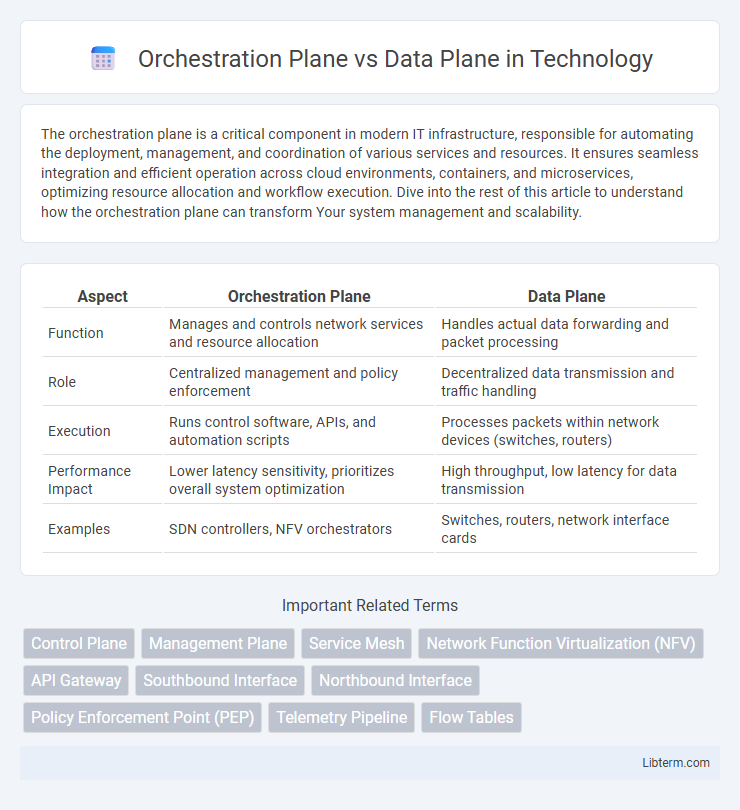The orchestration plane is a critical component in modern IT infrastructure, responsible for automating the deployment, management, and coordination of various services and resources. It ensures seamless integration and efficient operation across cloud environments, containers, and microservices, optimizing resource allocation and workflow execution. Dive into the rest of this article to understand how the orchestration plane can transform Your system management and scalability.
Table of Comparison
| Aspect | Orchestration Plane | Data Plane |
|---|---|---|
| Function | Manages and controls network services and resource allocation | Handles actual data forwarding and packet processing |
| Role | Centralized management and policy enforcement | Decentralized data transmission and traffic handling |
| Execution | Runs control software, APIs, and automation scripts | Processes packets within network devices (switches, routers) |
| Performance Impact | Lower latency sensitivity, prioritizes overall system optimization | High throughput, low latency for data transmission |
| Examples | SDN controllers, NFV orchestrators | Switches, routers, network interface cards |
Understanding Orchestration Plane and Data Plane
The Orchestration Plane manages the control and coordination of network resources, enabling automated provisioning, configuration, and policy enforcement across the infrastructure. The Data Plane, also known as the forwarding plane, is responsible for the actual transmission of user data packets based on rules set by the Orchestration Plane. Understanding the distinction between these planes is crucial for optimizing network performance, scalability, and security in software-defined networking (SDN) environments.
Key Functions of the Orchestration Plane
The orchestration plane manages and automates the deployment, configuration, and coordination of network services, ensuring efficient resource allocation and policy enforcement across the infrastructure. It handles lifecycle management tasks such as provisioning, scaling, and healing of virtualized network functions to optimize performance and reliability. By abstracting control and integrating analytics, the orchestration plane enables dynamic adjustments and centralized governance, differentiating it from the data plane's role in direct packet forwarding and data transfer.
Core Responsibilities of the Data Plane
The Data Plane is primarily responsible for the forwarding and processing of data packets based on established policies and routing decisions. It handles packet inspection, classification, encapsulation, and forwarding at high speed to ensure efficient network traffic flow. Its core functions include executing instructions from the control plane and maintaining data path integrity to support real-time communication and service delivery.
Architectural Differences: Orchestration vs Data Plane
The orchestration plane manages and coordinates network services, focusing on automation, policy enforcement, and resource allocation across multiple devices and domains. The data plane, however, handles the actual packet forwarding and processing, ensuring efficient traffic flow based on predefined rules and routing decisions. Architecturally, the orchestration plane operates at a higher abstraction level, interfacing with control planes and leveraging software-defined networking (SDN) controllers, while the data plane resides within network devices, performing real-time data transmission tasks.
How Orchestration and Data Planes Interact
The orchestration plane manages and controls the data plane by issuing policies, configurations, and workflows that dictate how data packets are processed and forwarded. It continuously interacts with the data plane to monitor real-time network performance, enabling dynamic adjustments in routing, load balancing, and security enforcement. This interaction ensures efficient resource utilization, scalability, and responsiveness in modern network infrastructures such as SDN (Software-Defined Networking) and NFV (Network Functions Virtualization).
Performance Impacts: Orchestration Plane vs Data Plane
The orchestration plane manages network resources and policies, influencing overall system responsiveness and scalability through control signaling efficiency. The data plane handles actual packet forwarding, directly impacting throughput and latency by processing traffic at line rate. Performance bottlenecks often arise when orchestration overhead delays data plane adjustments, highlighting the need for optimized coordination between both planes to ensure low latency and high throughput.
Security Considerations in Orchestration and Data Planes
Security considerations in the orchestration plane emphasize protecting control interfaces and ensuring secure authentication, authorization, and auditing to prevent unauthorized configuration changes. The data plane requires robust encryption, traffic filtering, and anomaly detection to safeguard data in transit and at rest from interception or tampering. Both planes must implement strict isolation and continuous monitoring to mitigate threats and ensure network integrity.
Real-World Use Cases for Each Plane
The orchestration plane manages and automates network resources, enabling dynamic service provisioning and policy enforcement in cloud environments and SD-WAN deployments. The data plane handles actual packet forwarding and traffic routing, ensuring low-latency processing in high-performance switches and routers used in telecom networks. Enterprises leverage the orchestration plane for centralized control and scalability, while the data plane supports real-time data transmission and hardware-accelerated networking tasks.
Challenges in Managing Both Planes
Managing the orchestration plane alongside the data plane presents significant challenges in synchronization and resource allocation, as each plane demands distinct operational priorities and real-time responsiveness. The orchestration plane requires dynamic decision-making for optimal workload distribution, while the data plane must ensure high-speed packet processing and minimal latency. Ensuring seamless integration between these planes involves addressing issues like scalability, fault tolerance, and consistent policy enforcement across diverse network functions.
Future Trends in Orchestration and Data Plane Technologies
Future trends in orchestration and data plane technologies emphasize enhanced automation and programmable networking to support dynamic, large-scale cloud environments. AI-driven orchestration platforms will optimize resource allocation and policy enforcement, while data planes will increasingly leverage hardware acceleration and programmable switches for faster, more efficient packet processing. Integration of intent-based networking and edge computing further drives the convergence of orchestration and data plane functionalities for real-time, distributed network management.
Orchestration Plane Infographic

 libterm.com
libterm.com